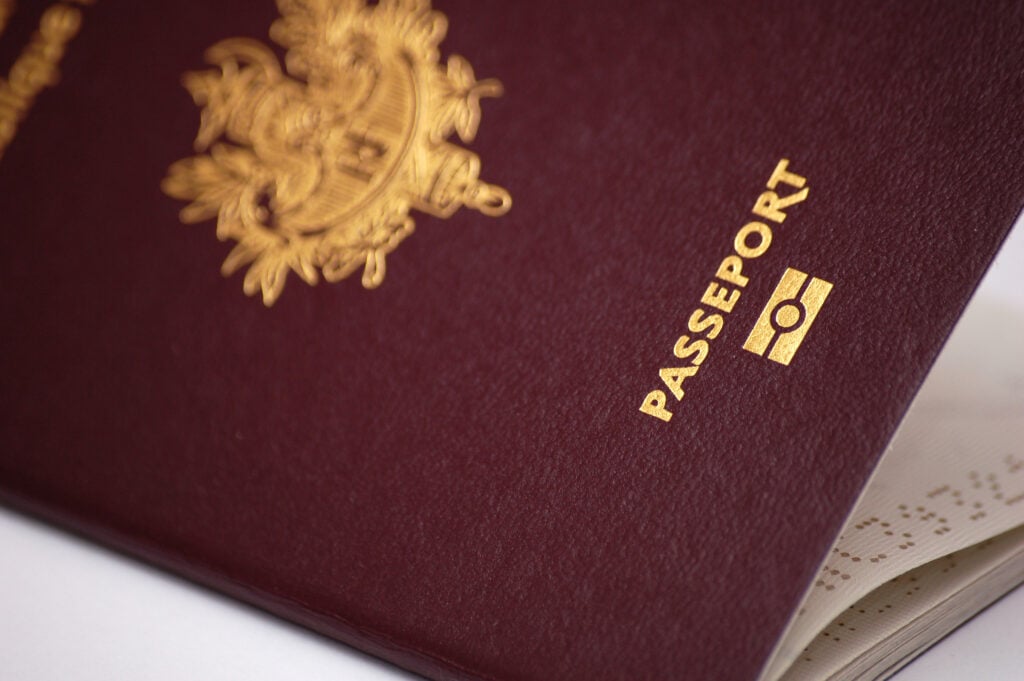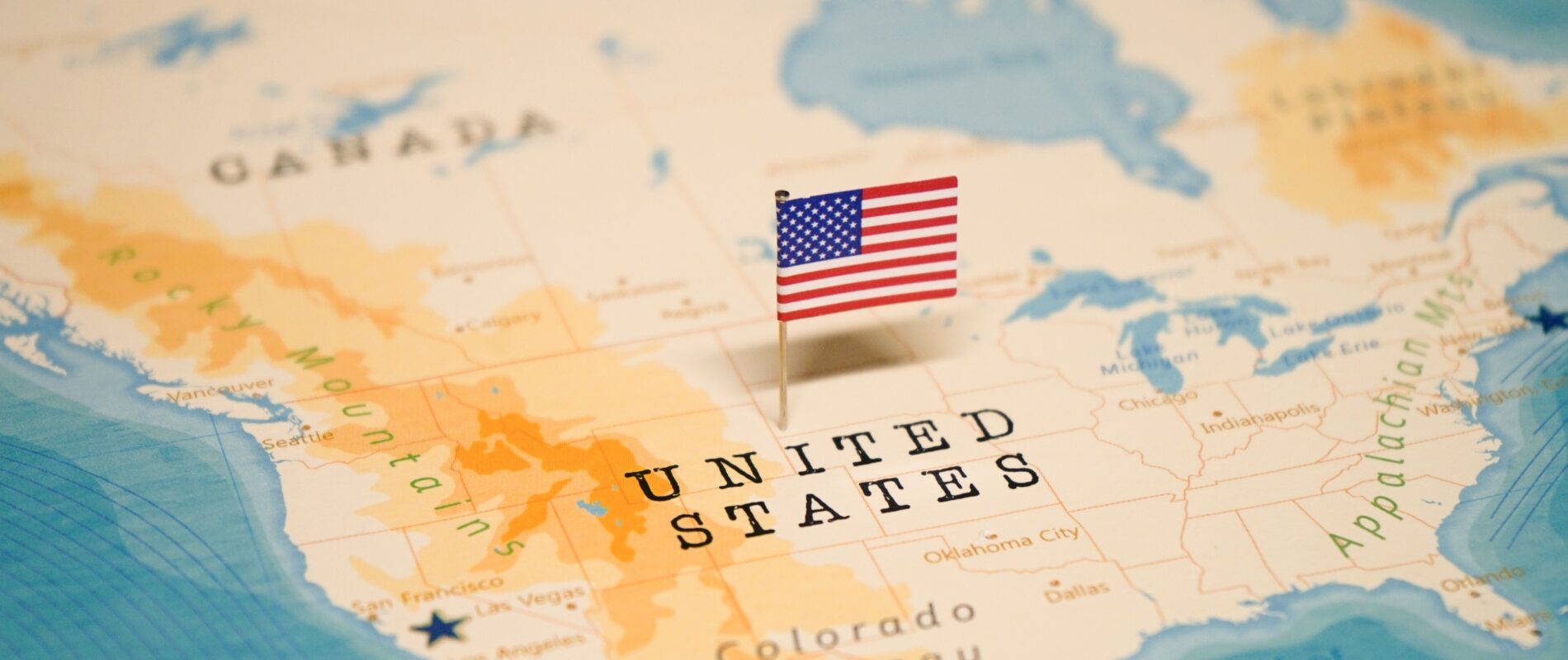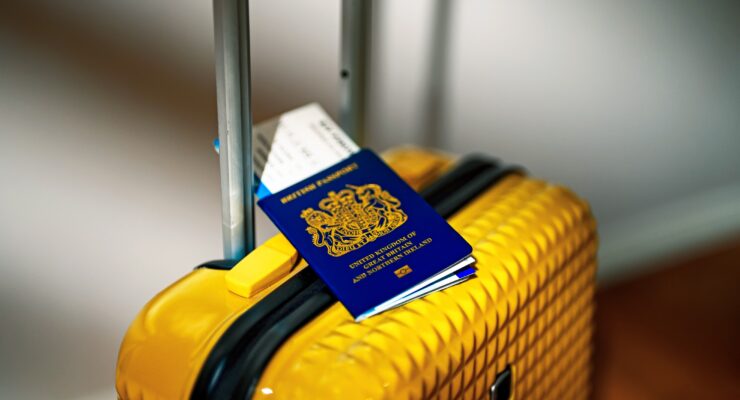If you’re already in Canada as an IEC permit holder, a permanent resident or tourist, why not make the most of your close proximity to the United States? So many opportunities for exploring await… you just need to cross the American border first! This article will explain all the steps you need to take to be granted entry to the US.
Click the buttons to navigate to:
1. Passport requirements for entry to the US
To travel to the US under the Visa Waiver Program (more on this below!), you must have a biometric or electronic passport (e-passport). To find out if you have an e-passport, look for this logo at the bottom of your passport:

If you don’t have an e-passport, you cannot use the Visa Waiver Program and must instead apply for a nonimmigrant visa at your nearest U.S. Embassy or Consulate. Don’t worry! Most countries do not need to be concerned about this requirement, as the majority of modern passports are e-passports.
Your passport must be valid for at least six months after your stay in the US.
2. Visa Waiver Program: The Electronic System for Travel Authorisation (ESTA)
If you are a citizen of one of the countries eligible for the Visa Waiver Program, you need to apply for an ESTA. This allows you to travel to the US (by any means of travel—air, land, etc.) for stays of up to 90 days without a visa. You must apply before your departure—allow at least one week for it to be processed; do not leave it until the day of departure! Once approved, your ESTA is valid for two years.
Note: Even if you are only planning a layover in the US and not leaving the airport, you still need an ESTA to board your flight. We will talk more about layovers in the US in the FAQs of this guide.
Beware of scams!
Watch out for scam websites. Here is the
official site to apply for the ESTA. The application is easy and costs US$21. If the website you are using is charging a higher fee than this, you know it’s a scam!
3. The visitor visa (if you don’t qualify for an ESTA)
If you are a citizen of a country that is not eligible for the Visa Waiver Program, you will need to apply for a visitor visa to visit the US.
Note that if your citizenship is eligible for the Visa Waiver Program but you have travelled to certain countries (Iran, Iraq, Sudan, Syria, Libya, Somalia, and Yemen on or after March 1, 2011, or Cuba on or after January 12, 2021), you will not be able to apply for an ESTA and must apply for a visa instead.
If you want to stay longer than 90 days, you can apply for the visitor visa, which will allow you entry for up to six months at a time. However, it’s just as easy to cross the border back into Canada and restart the 90 day timeframe. If you qualify for an ESTA, it’s much cheaper and easier to get than a visitor visa, so consider if you really need the visa before applying.
You must apply for your visitor visa several months before your date of departure. You will need to attend an in-person interview at a US embassy or consulate; you can enter your nearest location to check the wait times for available appointments here.
Once you have submitted all the documentation and attended an appointment, it can still take several weeks to process and be granted your visitor visa. Don’t leave it until the last minute!
Exception to needing an ESTA or visitor visa: Crossing by ferry
There is one specific
exception where you won’t need to apply for an ESTA/visitor visa. If you have permanent residency in Canada and plan to travel by ferry for tourism purposes only, you only need to show your passport. You must also have a completed I-94W form (see below for more info).
4. The I-94W form (required for land crossings)
If you plan to enter the US via a land border instead of flying, you will need an I-94W form as well as your ESTA. This helps US officials track your entry and departure—if you need the details, you can request your travel history online. For the I-94W form, you will have to pay US$6.
You can complete your I-94W form online in advance (no earlier than one week before departure, otherwise it will expire) or in-person at the border. There are pros and cons to each method—completing the form in advance will make your border crossing quicker, but waiting until the border means the officer will complete the form for you.
Most of the time, everything is done electronically. However, if the border officer uses the old, paper-based system, you will be given a physical card. You must keep this safe, as you will need to hand it back to the border officers when you depart, so that your exit from the country is correctly recorded.
Note: If you have a US visa (visitor or otherwise) instead of an ESTA, your form will be called the I-94 instead of the I-94W, but the process is the same.
5. How crossing the land border works
Entering the US by car
When you cross the American border, you will be asked to get out of your vehicle and leave any large bags in your car. Only take in what you need (phone, wallet, passport/documents, etc.)
You will be directed to a room where you will go through American customs. It’s very simple: the customs officer will ask you a few questions (Where are you going? What are you going to do there? For how long? etc.) to see if your plan is viable and to make sure you don’t have plans to overstay or work illegally. They may also ask to see proof of your status in Canada (e.g. your IEC work permit to prove temporary residency).
Be prepared to show the customs officer your itinerary to prove your plans are legitimate. Make sure you have the address you plan to stay at ready to give the officer. Be relaxed, cooperative and polite, and everything will be fine! Answer the questions they ask honestly.
Your fingerprints and photo will then be taken and you will be sent on your way.
At the large border crossings, be prepared for queues, especially during busy periods (e.g. public holidays). For a more relaxed atmosphere and a faster crossing, you can opt for a smaller border crossing. Even if this means making a small detour, you can sometimes save time there.
However, smaller border crossings are not always used to seeing tourists, so you may be grilled more about your reasons for crossing there!
Although it rarely takes more than 30 minutes, don’t forget to include the border crossing in your planned travel time.
Rental cars
If renting a car in Canada, make sure you check the rules of your rental company. Some companies won’t allow their cars to be taken across the border. Some will allow it but charge an extra fee or have extra conditions in the contract.
Entering the US by bus
If you are coming by bus (such as a tour bus or Greyhound), the customs process usually takes longer than if you are coming by car, as all passengers must get off the bus to go through customs before re-boarding the bus. It is not uncommon for one person to be held longer and for all passengers to have to wait for them.
Buses usually go through a different terminal than individual cars. You will be asked to take all your belongings with you when you get off the bus. The customs officers will check the empty bus. They may also check your personal belongings as you go through customs.
Entering the US by train
When you purchase your train ticket, your name will be transmitted to US Customs. Note that you must purchase your ticket before 8:30 am on the day of your travel, otherwise your name will not have been transmitted to them in time, and you will not be able to cross the border.
For travelling by train, you are also asked to complete your I-94W form in advance (rather than at the border). You must do this within seven days of your planned travel date.
Similar to travelling by bus, expect to get off the train and have your passport/documents inspected. You may need to take your luggage with you, and it may also be inspected. The customs officers will check the train. Be prepared for delays as each passenger completes the customs process and gets back on the train.
If there are any problems (for example, you are not on the list), you will have to exit the train and, depending on the issue, it may leave without you. However, if you take all the precautions recommended in this guide, there is no reason for this to happen!
For more information about the process of entering the US by train, visit the Amtrak website.
6. FAQs
Is it possible to bring my dog to the US?
Your dog must have been in Canada (or a dog-rabies free/low-risk country) for at least six months prior to entering the US. You must be able to show proof of rabies vaccination. Remember to bring your dog’s papers and vaccination record, and follow all rules set by the Centers for Disease Control and Prevention (CDC).
Do I need an ESTA or visa to flagpole?
As of December 2024, flagpoling is no longer allowed. For more info about the changes, read “Flagpoling” or how to cross the US-Canada border to activate your permit.
Can I use WWOOF or HelpX to volunteer in the US as a tourist?
With a visitor visa or ESTA, you don’t have the right to work in the United States. Volunteering (for example volunteering through WWOOF or HelpX) is considered work, even though it is unpaid work. You must look into work visas, which are difficult to obtain.
If you take the risk of working illegally and get caught, you will be deported. You will be prohibited from returning to the US, which will also impact you being able to return to Canada, since the two governments share their data. Unless you launch the lengthy and expensive process of rehabilitation, this is a lifetime ban. Essentially, the risk is up to you but it is hardly worth it!
Can I enter the US before activating my Canadian IEC permit?
Some people choose to go to the US, either for a holiday or a layover, before entering Canada to activate their IEC permit (Working Holiday, Young Professionals, International Co-op).
If you are only making a stopover by plane, you will need to apply for an ESTA. You will otherwise be fine, as the US will know you are only stopping in-transit.
If you decide to visit the US for a holiday before entering Canada, be warned that you may face issues if you cannot meet your ESTA conditions and prove you plan to leave North America within 90 days. Since Canada is part of North America, you can run into problems if you don’t have proof of an international flight leaving Canada within 90 days.
Note that once you have activated your IEC permit, you will have no problem crossing the border. IEC permit holders are considered temporary residents of Canada, so there is no need to prove intent to leave North America in the 90-day period.
If you have not yet activated your temporary residency in Canada, the US may not allow you entry if you cannot prove you have a flight booked to leave North America after 90 days. To avoid any problems, you should enter Canada first, activate your permit, then travel to the US for your holiday.
If you have onward transit out of North America booked (even if you want to book a cancellable flight and change it after you’ve been granted entry to the US), this is an option. However, it might prove to be more expensive than simply changing your flights to enter Canada first!
Remember that even with an approved ESTA or visitor visa, nothing guarantees you entry into the US. It is always up to you to prove to the border officer on the day that you intend to follow the rules. If they have any doubt, you may still be denied entry.


















0 comments
{{like.username}}
Loading...
Load more